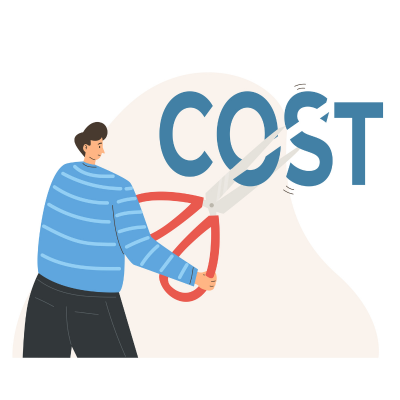In the fast-paced world of business, staying financially afloat is a constant challenge, especially for small enterprises. The key to survival often lies in implementing effective cost-cutting strategies. In this article, we’ll explore various ways small businesses can reduce expenses, delve into the concept of cost reduction strategy, provide real-life cost-cutting examples, and offer five actionable tips for cutting costs in 2024.
How Can a Small Business Cut Expenses?
Running a small business requires a delicate balance between revenue generation and expense management. To navigate this challenge successfully, it’s crucial for entrepreneurs to explore diverse approaches to cut costs.
Embrace Technology
In the digital age, technology can be a small business’s best friend. From cloud-based tools to automated processes, integrating technology into your operations can significantly reduce manual labor and associated costs. For instance, utilizing project management software can streamline tasks and enhance overall efficiency.
Negotiate with Suppliers
Establishing strong relationships with suppliers is essential for cost reduction. Regularly negotiate pricing, explore bulk purchase discounts, and seek alternative suppliers to ensure you’re getting the best deals. Small adjustments in supplier contracts can lead to substantial long-term savings.
Optimize Operational Efficiency
Review and streamline your business processes to identify areas for improvement. Analyze workflows to eliminate redundancies, enhance productivity, and reduce the time and resources required for tasks. This can lead to direct cost savings and increased overall efficiency.
Remote Work Policies
The shift towards remote work has become a prevalent trend, offering small businesses a unique opportunity to cut costs. By allowing employees to work remotely, you can reduce expenses related to office space, utilities, and other overhead costs. This flexibility can also boost employee satisfaction and productivity.
Outsourcing Non-Core Functions
Consider outsourcing non-core functions such as customer support, accounting, or IT services. Outsourcing allows you to access specialized expertise without the burden of hiring full-time staff, reducing payroll and operational costs.
What Is a Cost Reduction Strategy in Small Business?
Cost reduction is not merely about slashing expenses randomly. It involves a strategic approach to identify and eliminate unnecessary expenditures while preserving the value and efficiency of essential functions.
Conduct a Comprehensive Expense Audit
Before implementing any cost-cutting measures, conduct a thorough audit of your business expenses. Categorize costs into essential and non-essential, and prioritize areas that offer the most significant potential for savings.
Prioritize Cost Reduction Initiatives
Identify specific cost reduction initiatives based on the audit findings. Prioritize those that align with your business goals and have the least impact on essential operations. This strategic approach ensures that cost-cutting efforts contribute positively to your overall business objectives.
Monitor and Adjust
Implementing a cost reduction strategy is an ongoing process. Regularly monitor the effectiveness of your initiatives and be prepared to adjust based on changing circumstances. Flexibility is key to ensuring long-term success in managing expenses.
Cost Cutting Strategy Examples
Let’s explore real-life examples of successful cost-cutting strategies employed by businesses to inspire and guide small enterprises in their own initiatives.
Energy-Efficient Measures
Many businesses have successfully reduced operational costs by implementing energy-efficient measures. This includes upgrading to energy-saving appliances, optimizing lighting systems, and adopting eco-friendly practices. Beyond cost savings, these initiatives also contribute to environmental sustainability.
Cross-Training Employees
Cross-training employees to handle multiple roles within the company is a cost-effective strategy. This not only reduces the need for specialized staff but also enhances employee skill sets, leading to a more versatile and agile workforce.
Digital Marketing Over Traditional Advertising
In the realm of marketing, businesses are increasingly shifting from traditional advertising methods to digital marketing. This transition allows for more targeted and cost-effective campaigns, reaching a larger audience without the hefty price tag associated with traditional media.
5 Ways to Cut Costs for Your Small Business In 2024
As we look ahead to 2024, it’s essential for small businesses to stay ahead of the curve in terms of cost-cutting. Here are five actionable tips tailored for the upcoming year.
1. Embrace Sustainable Practices
Investing in sustainable practices not only aligns with modern values but can also result in cost savings. From reducing paper usage to adopting eco-friendly packaging, sustainability can positively impact both the environment and your bottom line.
2. Leverage Data Analytics
Harness the power of data analytics to make informed decisions about your business. Analyzing data can reveal inefficiencies, customer trends, and areas for improvement, allowing you to optimize operations and allocate resources more effectively.
3. Explore Subscription-Based Services
In the digital age, many essential services are offered on a subscription basis. Evaluate your business needs and consider subscribing to software, tools, and services on a monthly basis rather than making large upfront investments. This can lead to significant savings over time.
4. Employee Wellness Programs
Investing in employee wellness programs may seem counterintuitive to cost-cutting, but it can have long-term financial benefits. Healthy and engaged employees are more productive, leading to improved overall efficiency and reduced healthcare costs in the long run.
5. Emphasize Lean Inventory Management
Maintaining excessive inventory ties up capital and can lead to increased storage costs. Emphasize lean inventory management by adopting just-in-time principles. This ensures that you have the necessary inventory to meet demand without the financial burden of excess stock.
Conclusion
Navigating the intricacies of expense cost-cutting strategies for small businesses requires strategic thinking, adaptability, and embracing modern approaches. By implementing the right measures, small businesses can not only survive but thrive in an ever-evolving business landscape. If you’re ready to take your small business to the next level, we encourage you to apply for a small business loan at ROK Financial, the alternative finance firm that is dedicated to supporting entrepreneurs like you. Take that bold step and unlock the potential of your business today!




